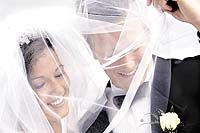| The wedding veil dates back antiquity and were orginally used to ward off evil spirits. |
Who would’ve thought a thin piece of lace or tulle could truly make a bride look and feel like she is getting married.
Veils have remained an important part of wedding day attire for centuries. Veils date back to ancient Greeks and Romans, who used them to fend off evil spirits and demons.
The thinking was that the evil spirits would not be able to get to the person behind the veil, hence keeping her safe for her husband. In the late eighteenth century in America, veils became quite popular. Aides to George Washington saw his stepgranddaughter Nellie sitting by a lace-curtained window and remarked on her stunning beauty. Nellie recreated the scene at her wedding by making a veil of white lace.
Today’s brides still take part in the tradition of the veil, but add their own spin on the accessory. Veils typically correspond to the color of the gown. White represents the ultimate purity of the bride.
A veil can be whatever you want it to be, from simple and understated to extravagant and detailed.
It can also be any length, from cascading beyond the wedding train to ending at the bride’s elbow.
No matter what you choose in a veil, it’s important that it complements your overall look and doesn’t compete with your gown.
A fancy veil will be too much for a detailed gown, but you can embellish a plain dress with a detailed veil.
When selecting veils, it helps if you have an image of your gown in mind. Some dress shops also specialize in veils, so you may be able to try on your gown and different veils to compare looks. It is also wise to style your hair and makeup similar to how you will wear it on your wedding day. This way you can experience the full effect.
When observing yourself in the veil, try it on in front of a full-length mirror, and view yourself from all angles. A veil may look flattering from the front, but may not complement the back of your gown.
Don’t forget to walk around the house or dress shop in your veil, especially if you are choosing one of considerable length. This way you can grow accustomed to maneuvering with the veil on and avoid tripping on your big day.
While veils are very beautiful, they are entirely optional for the bride (unless your house of worship has rules regarding veils).
Many other headpieces and accessories are available if you opt out of a veil. These include tiaras, barrettes, hats, and more.

